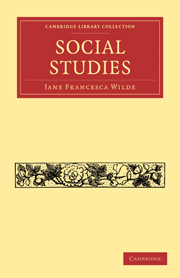Book contents
- Frontmatter
- Contents
- WORKS BY LADY WILDE
- THE BONDAGE OF WOMAN
- GENIUS AND MARRIAGE
- SOCIAL GRACES
- VENUS VICTRIX
- SPIRITUAL AFFINITY
- SUITABILITY OF DRESS
- AMERICAN WOMEN
- THE WORLD'S NEW PHASES
- THE DESTINY OF HUMANITY
- AUSTRALIA (a Plea for Emigration)
- THE VISION OF THE VATICAN
- IRISH LEADERS AND MARTYRS
- THE POET AS TEACHER
- THE TWO ARTISTS: A SKETCH (from the Spanish)
- ‘TERTIA MORS EST’ (from the German,)
‘TERTIA MORS EST’ (from the German,)
Published online by Cambridge University Press: 05 March 2012
- Frontmatter
- Contents
- WORKS BY LADY WILDE
- THE BONDAGE OF WOMAN
- GENIUS AND MARRIAGE
- SOCIAL GRACES
- VENUS VICTRIX
- SPIRITUAL AFFINITY
- SUITABILITY OF DRESS
- AMERICAN WOMEN
- THE WORLD'S NEW PHASES
- THE DESTINY OF HUMANITY
- AUSTRALIA (a Plea for Emigration)
- THE VISION OF THE VATICAN
- IRISH LEADERS AND MARTYRS
- THE POET AS TEACHER
- THE TWO ARTISTS: A SKETCH (from the Spanish)
- ‘TERTIA MORS EST’ (from the German,)
Summary
In the year 1665, Daniel Muller, afterwards Professor of Jurisprudence, lived at Colmar as tutor to the three sons of a certain Burgomaster of high repute in the town, named Steinberg. Now it happened that in the October of that year a travelling alchemist was received and entertained by Steinberg as his guest, and at supper, amongst other seasonable condiments, a dish of nuts being on the table, the conversation turned on their many good qualities and uses.
The three pupils of Muller were, however, entirely absorbed in their consumption, and the nuts were so rapidly seized, crushed and demolished, that Muller, as a good-natured reproof, gave them three lines to translate from the Schola Saliterna—
Unica mix prodest
Nocet altera
Tertia mors est,
which they rendered—One nut is good, the second hurts, but the third is death.
‘Well.’ said Muller, laughing, ‘this can hardly be true, for you have gone much beyond the third nut, yet there is no sign of death on you; so we can't believe in the tertia mors est.’
Scarcely were the words uttered when the alchemist started from the table in violent agitation, and, without any apology to his host, rushed from the room, leaving the company in no little amazement.
The Burgomaster at once sent his eldest son after him to know if he could in any way be of service to him, fearing he was ill.
- Type
- Chapter
- Information
- Social Studies , pp. 321 - 344Publisher: Cambridge University PressPrint publication year: 2010First published in: 1893



